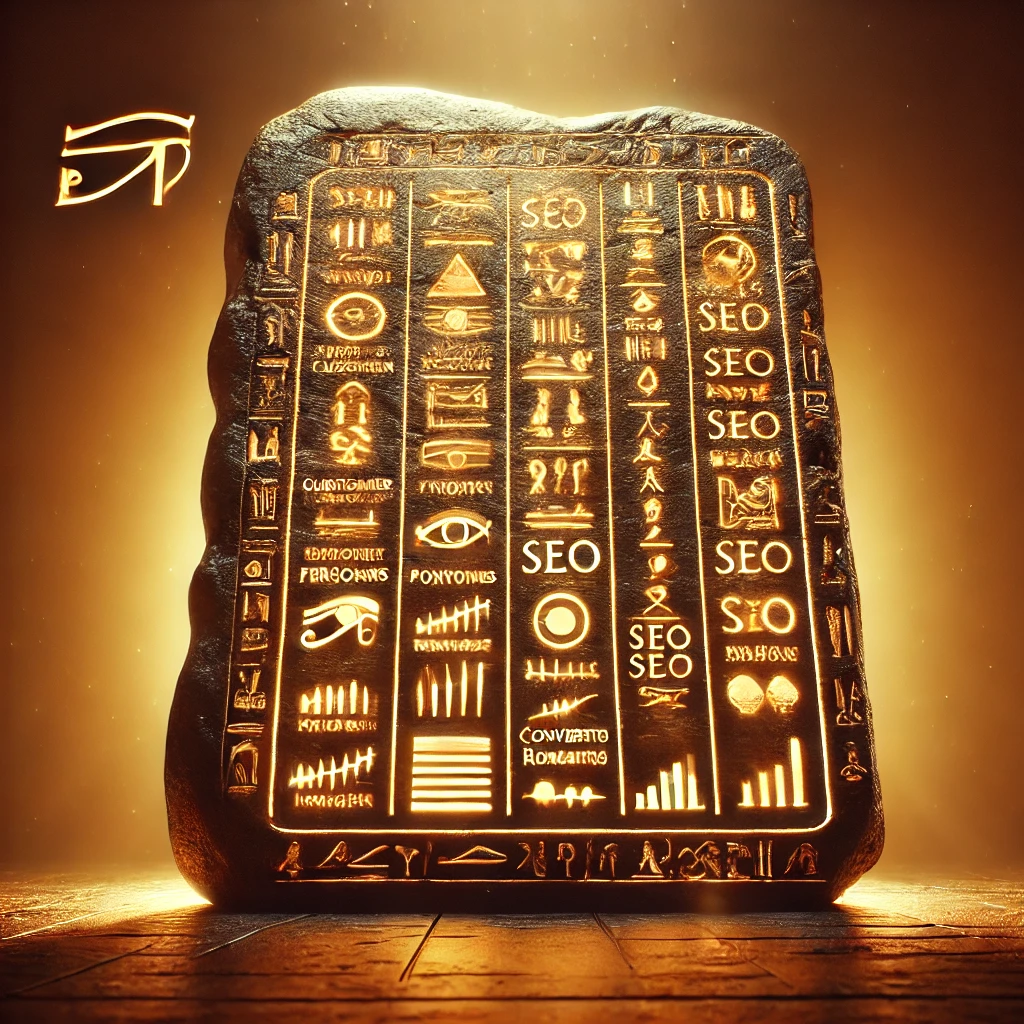Throughout history, some of the greatest treasures have remained hidden for centuries—locked away in forgotten tombs, buried beneath shifting sands, waiting for those bold enough to search beyond the obvious. The same can be said for marketing opportunities.
Most businesses dig in the same places, relying on the same overused strategies, simply because they see competitors doing it. But what if the real opportunities—the ones that can set you apart—aren’t where everyone else is looking?
Like an archaeologist searching for lost relics, the best marketers aren’t just trend followers—they’re strategic explorers. They know that competitive research, data analytics, and creative problem-solving reveal gaps in the market that others overlook. These hidden opportunities aren’t just a luxury—they’re a necessity for businesses that want to thrive instead of just compete.
In this article, we’ll uncover:
- Why businesses often miss hidden marketing opportunities.
- How research and competitive analysis expose the gaps others ignore.
- Modern and traditional marketing strategies that are underutilized but powerful.
- How to use data to guide your strategy—like finding clues on an ancient treasure map.
The difference between a leader and a follower in business isn’t who has the biggest budget—it’s who sees what others don’t. Let’s start digging.
The Map to Lost Opportunities – Why Businesses Overlook Hidden Gems

If hidden marketing opportunities exist, why don’t more businesses take advantage of them? It’s not for lack of effort—it’s because they’re too focused on what’s already visible rather than what’s beneath the surface.
Here’s why businesses often miss out on hidden opportunities:
1. They Follow Instead of Lead
Most businesses watch their competitors and try to replicate their success. If a competitor is running Facebook ads, they run Facebook ads. If others focus on LinkedIn, they do the same. But this copycat approach only ensures they stay one step behind—not ahead.
🔍 Solution: Instead of blindly following trends, analyze competitors for what they’re missing. Ask:
- What channels are they ignoring?
- Where are they underperforming?
- What gaps exist in their customer engagement, messaging, or content strategy?
2. They Rely on Surface-Level Data
Businesses often look at vanity metrics—like social media likes or basic website traffic—without digging into deeper analytics. They fail to ask:
- Where are the most engaged leads actually coming from?
- What niche search terms are people using that competitors aren’t optimizing for?
- What unexpected behaviors are showing up in customer data that indicate an untapped demand?
🔍 Solution: Use tools like SEO gap analysis, heatmaps, and customer journey mapping to spot patterns others miss. Look at what’s working beneath the surface—not just what looks good on paper.
3. They Fear Unproven Strategies
Many brands hesitate to explore new marketing channels, underused platforms, or experimental tactics because they don’t want to take risks. But the biggest wins often come from stepping outside the comfort zone.
🔍 Solution: Test small-scale versions of untapped marketing strategies before making major investments. Pilot campaigns, A/B tests, and localized efforts allow you to measure success before committing long-term.
4. They Don’t Look Beyond Their Own Industry
Most brands limit their marketing inspiration to what their direct competitors are doing. But some of the best ideas come from other industries entirely.
🔍 Solution: Study marketing strategies from industries different from yours—what’s working for tech companies, entertainment brands, and e-commerce giants that you can adapt to your space?
Why This Matters
The greatest marketing treasures aren’t found in the obvious places. They’re hidden beneath unexamined data, overlooked strategies, and competitor blind spots.
The key to discovering them is developing the mindset of a marketing archaeologist—analyzing, questioning, and testing rather than just following the crowd.
The Secret Passages of Digital Marketing – Unexplored Avenues

The internet is full of hidden passageways—places where attention is high, competition is low, and the right strategy can yield massive rewards. Yet, most businesses stick to crowded, well-trodden paths like traditional SEO, paid ads, and basic social media strategies.
To truly uncover new marketing opportunities, brands need to look beyond the obvious and explore digital channels that are often overlooked.
🔹 Competitor Gap Analysis – Finding the Missing Pieces
Businesses should analyze what they’re neglecting instead of just copying what competitors are doing well.
🔍 How to do it:
- Use SEO tools to see which keywords your competitors rank for—and which they’re ignoring.
- Analyze their backlink profile—what high-authority sites link to them? What opportunities exist for you to secure links where they haven’t?
- Look at their content strategy—are they ignoring certain audience pain points or topics?
Example: A local law firm sees competitors focusing only on “personal injury lawyer” keywords but finds huge untapped search volume for niche terms like “rideshare accident claims” and “workers’ compensation appeals”—where no one is competing aggressively.
🔹 Owned Media Renaissance – Using Your Own Platform for SEO Power
Too many businesses chase social media trends but neglect their own platforms. Owned media—like blogs, podcasts, and press releases—provides a long-term SEO advantage and direct audience control.
Hidden Opportunity: Most businesses don’t realize that podcasts generate high-quality backlinks from Spotify, Apple, Google, and other major platforms—making them an SEO goldmine with minimal competition.
🔍 How to leverage owned media for hidden traffic:
- Start a branded podcast—get instant high-authority backlinks and regular, fresh content for Google.
- Repurpose blog content into LinkedIn articles, video scripts, and press releases—maximizing every piece.
- Use strategic press releases to get featured in news sites that build credibility and domain authority.
Example: A B2B consultant struggling with SEO launches a simple podcast series discussing industry trends. Within months, their business appears on page one of Google—ranking above competitors—due to consistent backlinks from major platforms.
🔹 Invisible Communities – High-Intent Audiences That Brands Overlook
Most brands focus on Facebook, LinkedIn, and Instagram, but there are entire digital communities thriving outside these mainstream platforms.
Hidden Opportunity: Forums, private groups, and niche platforms often contain higher-intent audiences than mainstream social media.
🔍 Where to look:
- Reddit & Quora: Search for industry-related questions and provide expert answers to build brand authority.
- Discord & Slack Communities: Join or create industry-specific groups where your ideal customers already gather.
- Private LinkedIn & Facebook Groups: Many high-value networking conversations happen here—not on public pages.
Example: A SaaS company selling B2B automation tools found that instead of running LinkedIn ads, they could drive higher conversions just by actively engaging in invite-only Slack communities where their target audience already sought software recommendations.
🔹 Interactive Content – The Engagement Hack Most Brands Ignore
Content isn’t just about blogs and social posts anymore. Quizzes, calculators, and interactive tools often generate higher engagement, backlinks, and conversions than traditional static content.
Hidden Opportunity: Most competitors won’t bother creating interactive tools because they assume it’s too complex—giving those who do an instant competitive edge.
🔍 How to leverage interactive content:
- Create a simple industry quiz (e.g., “What type of SEO strategy is right for your business?”)
- Develop a free calculator tool (e.g., ROI calculators, pricing estimators, etc.)
- Use gamification (badges, leaderboards) to drive engagement.
Example: A marketing agency created a free “SEO Score” quiz for small businesses. Within months, it became their #1 lead generation tool, driving more sign-ups than paid ads.
The Forgotten Artifacts of Traditional Marketing, Reinvented
While digital marketing evolves rapidly, some of the best opportunities come from blending old-school tactics with modern tools. The key is modernizing traditional marketing methods to make them relevant today.
🔹 Direct Mail 2.0 – QR Codes, NFC, & Augmented Reality
Direct mail isn’t dead—it’s just underutilized by modern marketers.
🔍 How to modernize direct mail:
- Use QR codes to drive offline engagement into digital actions.
- Implement NFC-enabled business cards that allow instant link-sharing.
- Create augmented reality (AR) experiences that bring mailers to life.
Example: A real estate agency used postcards with QR codes linking to virtual property tours. Adding QR codes made their traditional marketing strategy more effective AND trackable.
🔹 Event-Based Networking – The Power of In-Person Engagement
With digital fatigue growing, in-person events are making a massive comeback. Businesses that invest in real-world touchpoints gain a competitive advantage.
🔍 Hidden Opportunity:
- Host intimate networking dinners, workshops, or pop-ups instead of traditional trade shows.
- Partner with influencers or micro-celebrities to make small events more impactful.
- Use live streaming + in-person hybrid events to reach both local and digital audiences.
Example: A personal finance brand hosted small, invite-only workshops in major cities instead of big conferences. Because of the exclusivity, demand skyrocketed—and so did their brand’s perceived authority.
🔹 SMS & Personalized Messaging – The Overlooked Goldmine
Most brands focus on email marketing but ignore SMS marketing, despite text messages having a 98% open rate compared to email’s 20-30% average.
🔍 How to use SMS without being spammy:
- Personalize messages based on customer actions.
- Use SMS for appointment reminders, exclusive deals, or VIP content.
- Integrate SMS into customer service for a better experience.
Example: A fitness coach used weekly motivational texts with workout tips. Clients stayed engaged far longer than email subscribers, reducing churn by 30%.
The Power of Strategic Alliances – Partnerships That Scale
Throughout history, empires rose not just through military strength but through strategic alliances—agreements that expanded influence, secured resources, and ensured long-term dominance. In marketing, the same principle applies: businesses that collaborate with the right partners unlock new audiences, increase brand authority, and create marketing opportunities their competitors aren’t leveraging.
Most businesses think too small regarding partnerships, assuming collaborations have to be big-name sponsorships or expensive influencer deals. But the reality is that some of the most overlooked and cost-effective marketing tactics involve cross-industry partnerships, media placements, and niche influencer relationships.
🔹 Podcast & PR Collaborations – A Backlink & Visibility Goldmine
Many businesses fail to recognize how much brand authority, credibility, and SEO value they can generate by simply being featured guests on podcasts and media outlets.
Hidden Opportunity:
- Guesting on a podcast can earn you backlinks from high-authority platforms like Apple, Spotify, and Google Podcasts—boosting your SEO rankings.
- Co-hosting a podcast series allows you to position yourself as an expert while bringing in guest collaborators who will share the content with their audience.
- Press features and interviews create long-term digital assets that continue to bring in organic traffic and authority for years.
🔍 How to leverage this strategy:
- Make a list of podcasts in your industry and reach out to be a guest.
- Submit press releases to media outlets and PR sites, ensuring brand mentions that improve your credibility and search rankings.
- Co-create content with other businesses in your space (guest blogs, webinars, video interviews) that each party can distribute to their audience.
Example: A marketing consultant struggling with online visibility secured guest spots on 10 marketing podcasts. Within months, he ranked higher on Google due to backlinks from high-authority domains like Apple and Forbes Podcasts.
🔹 Industry Cross-Promotions – Expanding Without Competing
Most businesses assume partnerships only make sense within their industry. But some of the most powerful collaborations happen between complementary businesses—where audiences overlap, but competition doesn’t exist.
Hidden Opportunity:
- Restaurants & Fitness Coaches → A nutritionist collaborates with a restaurant to create a custom meal plan menu that both promote.
- Financial Advisors & Business Coaches → A business coach hosts a joint webinar with a financial planner, offering value to both audiences.
- Local Service Providers → A real estate agent partners with a moving company for co-branded promotions.
🔍 How to leverage this strategy:
- Identify non-competing businesses with similar audiences.
- Offer bundled services or joint promotions where both brands benefit.
- Leverage each other’s email lists, social channels, and websites to cross-promote content and increase exposure.
Example: A boutique skincare brand partnered with a yoga studio for a joint wellness campaign, offering special discounts to each other’s clients. The result? A 32% boost in cross-sales with no ad spend required.
Unlocking the Hidden Tomb – A Framework for Discovering Your Own Untapped Opportunities

Discovering hidden marketing opportunities isn’t about luck—it’s about approaching your strategy like an archaeologist, using data, research, and testing to find high-value, low-competition spaces.
Here’s how to systematically uncover untapped growth channels:
🔹 Competitive Research: The Modern Archaeologist’s Tool
Most businesses look at what their competitors are doing—but few study what they’re missing.
🔍 How to do it:
- SEO Gap Analysis: What keywords aren’t your competitors targeting?
- Customer Reviews & Pain Points: What are customers complaining about that no one addresses?
- Backlink Audits: Where is your competition getting traffic from, and what sites could you target instead?
🔹 Data-Driven Discovery: Finding Clues in the Numbers
Sometimes the best marketing insights come from patterns in your own analytics. Businesses ignore subtle signals that could indicate massive untapped opportunities.
🔍 What to look for:
- Which blog posts or social media topics get engagement spikes? This could be a market demand signal.
- Which referral sources bring in traffic unexpectedly? Could this be a new place to build content partnerships?
- Which customer segments are growing fastest? This might signal a new niche worth doubling down on.
🔹 Test Before You Dismiss – The Low-Risk Way to Validate Opportunities
Many businesses don’t pursue new marketing ideas because they fear wasted effort. But small-scale tests allow you to measure viability before committing fully.
🔍 How to test a new marketing channel before going all-in:
- Run a low-budget paid ad test to see if there’s demand.
- Create a small content piece (guest post, podcast episode) and measure its impact before scaling.
- Launch a mini partnership campaign with one collaborator and gauge response before expanding.
Example: A B2B software startup noticed an unusual spike in LinkedIn engagement on posts about “automation in hiring.” Instead of ignoring it, they ran a small LinkedIn ad test on the topic, which led to a new product feature launch based on audience demand.
Becoming the Marketing Archaeologist – Turning Insights into Action
Throughout history, the greatest discoveries weren’t stumbled upon—they were uncovered by those willing to dig deeper, look beyond the obvious, and follow the clues others ignored. The same is true for marketing.
Most businesses follow trends, copy competitors, and play it safe—but true success comes from exploring untapped opportunities, leveraging research, and testing new strategies before the competition catches on.
The Key Takeaways from the Hidden Tomb
- Hidden marketing opportunities exist—but they won’t reveal themselves unless you actively search beyond the obvious.
- Competitive research is your treasure map—use it to find what your competitors aren’t doing rather than simply copying what they are.
- Your owned media is an untapped goldmine—leveraging podcasts, press releases, and strategic content collaborations can boost authority and SEO faster than traditional methods.
- Traditional marketing still works when modernized—QR codes, NFC, in-person networking, and SMS marketing all hold massive untapped potential when used strategically.
- The best marketing strategies combine data and intuition. They use analytics, A/B testing, and audience insights to find hidden demand and validate new ideas before scaling.
The Final Thought – Keep Digging
The businesses that win aren’t the ones with the biggest budgets—they’re the ones that see opportunities before anyone else does.
The Hidden Tomb of Marketing isn’t a single place or strategy—it’s a way of thinking.
If you want to stay ahead, don’t just follow the same old paths. Look where others haven’t. Test ideas they’ve dismissed. And most importantly—never stop digging.




